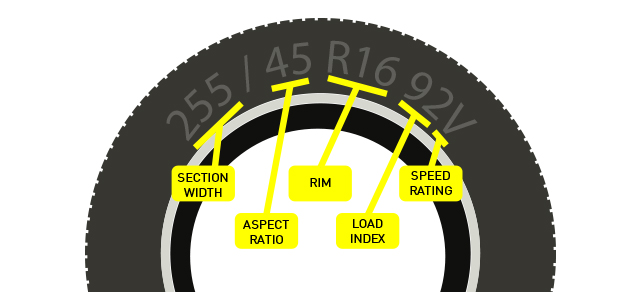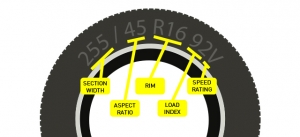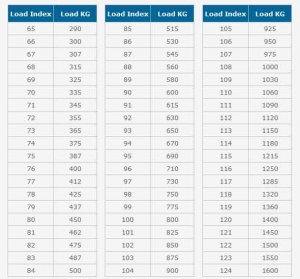UNDERSTANDING TYRE LOAD INDEX
Looking after your vehicle means making sure it is safe and comfortable to use. Checking the parameters of your vehicle’s tyres is an important step that shouldn’t be overlooked, and the tyre load index is just one aspect that will need to be investigated before investing in replacement tyres.
What is the tyre load index?
A tyre load index describes the maximum load, or weight, that an individual tyre is able to safely carry when inflated to the safe, recommended tyre pressure. Different makes and models of tyres have different tyre load indexes, which is detailed on the sidewall – usually it is displayed as a two or three digit number that follows the numbers describing the dimensions of the tyre.
Section/tyre width
The width of your tyre, in millimetres, measured from sidewall to sidewall.
Aspect ratio
This is the ratio of the tyre’s cross-section to its width, expressed as a percentage. An aspect ratio of 65, for example, indicates that the tyre’s height is 65% of its width.
Rim/wheel diameter
The diameter (height) of the wheel in inches.
Load index
Your tyre’s load index relates to its maximum carrying capacity (in kg). You’ll find the load rating of your tyre on the sidewall, just to the right of the diameter. For example, a tyre with a load index of 91 can carry 615kg of weight. Load ratings and speed ratings should be looked at together when you buy a new tyre. Also remember to check your manufacturer’s recommendations.
Speed rating
The speed rating is the maximum speed for a tyre when it is correctly inflated and being used under load. The speed rating is the letter at the end of the sidewall, after the load index number. A tyre with a speed rating of V, for example, has a maximum speed of 240 km/h. When buying new tyres, make sure you match their speed rating with the speed capabilities of your vehicle.
Why is the tyre load important for drivers?
Overloading tyres can be unsafe and lead to tyre damage. You must ensure that a tyre with a suitable load index is fitted to your vehicle – never affix tyres that have a lower load capacity than recommended.
Recommendations can usually be found in your vehicle handbook, which should detail the appropriate range of load indexes that any new tyres will need, in relation to your specific vehicle. Failure to heed this advice could lead to the fitting of a tyre with an incorrect load index, which could cause problems with insurance, and may even invalidate certain policies.
How to use the tyre load index
To the right you will find our handy tyre load index chart which outlines the maximum weights attributed to each load index rating – highlighting exactly how much weight a tyre can safely carry. To calculate the total carrying capacity for your car as a whole, simply multiply the single tyre load index by four.






Trackbacks & Pingbacks
worldwide internet dating https://freewebdating.net/
best single sites https://freedatinglive.com/
meet singles free https://allaboutdatingsites.com/
best free online dating sites https://datingwebsiteshopper.com/
best site for online dating https://onlinedatinghunks.com/
village ladies totally free https://onlinedatingsuccessguide.com/
free dating date https://onlinedatingsurvey.com/
single website https://sexanddatingonline.com/
village ladies totally free https://free-dating-sites-free-personals.com/
local free chatline https://jewish-dating-online.net/
facebook dating https://freewebdating.net/
custom coursework https://courseworkdomau.com/
coursework writer uk https://buycoursework.org/
design and technology gcse coursework https://teachingcoursework.com/
coursework writers https://coursework-expert.com/
coursework psychology https://courseworkinfotest.com/
coursework writer uk https://courseworkdownloads.com/
coursework questions https://mycourseworkhelp.net/
coursework sample of written work https://writingacoursework.com/
coursework support https://courseworkninja.com/
design and technology gcse coursework https://brainycoursework.com/
1accelerated
instant paper writer https://studentpaperhelp.com/
paying someone to write a paper https://ypaywallpapers.com/
writing paper help https://premiumpapershelp.com/
professional paper writing services https://papercranewritingservices.com/
custom written paper https://essaybuypaper.com/
write my paper https://writemypaperquick.com/
order a paper online https://mypaperwritinghelp.com/
buy literature review paper https://buyessaypaperz.com/
college paper writer https://writingpaperservice.net/
can you write my paper https://cheapcustompaper.org/
buy a college paper online https://researchpaperswriting.org/
write my paper for me cheap https://top100custompapernapkins.com/
where can i find someone to write my paper https://doyourpapersonline.com/
where to buy resume paper https://write-my-paper-for-me.org/
buy a paper for college https://writepapersformoney.com/
help writing my paper https://paperwritinghq.com/
write my custom paper https://uktermpaperwriters.com/
customized writing paper https://sociologypapershelp.com/
pay for paper https://term-paper-help.org/
gay teen cam chat room https://gaymanchatrooms.com/
ierracial gay chat rooms https://gayinteracialchat.com/
gay chat rooms ring central https://free-gay-sex-chat.com/
cam chat gay https://gaymusclechatrooms.com/
gay chat for windows https://gaychatnorules.com/
gay cumshot chat https://gayphillychat.com/
free asian chat lines gay https://chatcongays.com/
gay jerk off chat https://gay-live-chat.net/
dick.net gay chat https://gaychatcams.net/
easy gay chat https://newgaychat.com/
hardrock online casino https://casinosonlinex.com/
las vegas usa online casino https://online2casino.com/
echeck online casino https://onlinecasinos4me.com/
best internet dating service https://onlinedatingservicesecrets.com/
dating apps free https://zonlinedating.com/
100% free dating sites no fees https://virtual-online-dating-service.com/
best date online https://freeadultdatingpasses.com/
our time dating website https://lavaonlinedating.com/
best app for meetings online free https://wowdatingsites.com/
which online dating site is best? https://datingpersonalsonline.com/
top dateing sites https://speedatingwebsites.com/
adult singles https://adult-classifieds-online-dating.com/
online dating meet https://adult-singles-online-dating.com/
yahoo dating personals https://onlinedatingbabes.com/
online sex dating https://freephotodating.com/
gay chubby chaser dating https://datinggayservices.com/
tree gay men dating sites missouri https://gayedating.com/
gay black dating site https://gay-singles-dating.com/
international vpn service https://rsvpnorthvalley.com/
best free windows vpn 2017 https://free-vpn-proxy.com/
free vpn website https://superfreevpn.net/
best vpn for apple https://imfreevpn.net/
vpn torrent https://ippowervpn.net/
best vpn 2019 https://freehostingvpn.com/
best vpn for utorrent https://shiva-vpn.com/
free nord vpn accounts https://freevpnconnection.com/
admiral online casino https://casino8online.com/
aladdin online casino https://all-online-casino-games.com/
new online casino no deposit bonus https://ownonlinecasino.com/
betmgm pa online casino https://onlineplayerscasino.com/
live online casino pa https://casino-online-jackpot.com/
spain online casino https://casino-online-roulette.com/
greektown casino online https://vrgamescasino.com/
vegas online casino https://1freeslotscasino.com/
caesars casino online https://cybertimeonlinecasino.com/
online casino ideal https://internet-casinos-online.net/
mobile casino online https://free-online-casinos.net/
las atlantis online casino https://9lineslotscasino.com/
free casino games online https://onlinecasinosdirectory.org/
no deposit bonus online casino https://trust-online-casino.com/
real casino games online https://newlasvegascasinos.com/
red dog online casino https://onlinecasinofortunes.com/
slots casino online https://firstonlinecasino.org/
uk online casino https://download-casino-slots.com/
what is dissertation https://customthesiswritingservices.com/
how long is a doctoral dissertation https://dissertationhelperhub.com/
dissertation service https://dissertationhelpspecialist.com/
doctoral dissertation help thesis https://writingadissertationproposal.com/
doctoral dissertation https://customdissertationwritinghelp.com/
what is a dissertation paper https://businessdissertationhelp.com/
dissertation assistance https://bestdissertationwritingservice.net/
dissertation writing support https://writing-a-dissertation.net/
custom dissertation writing https://examplesofdissertation.com/
writing editing services https://accountingdissertationhelp.com/
format for writing dissertation proposals https://dissertationhelpexpert.com/
uk dissertation writing help online https://dissertationwritingcenter.com/
doctoral dissertation defense https://helpwithdissertationwritinglondon.com/
phd dissertation help download https://professionaldissertationwriting.com/
proposal and dissertation help 2000 words https://professionaldissertationwriting.org/
3cardiovascular
1braxton
Leave a Reply
Want to join the discussion?Feel free to contribute!